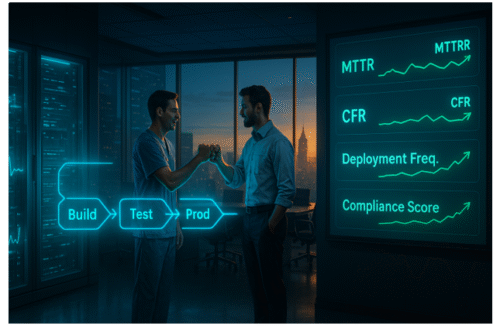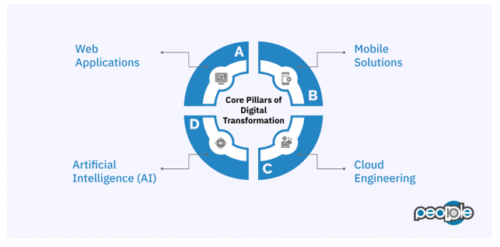Mint Miner Launches Cloud Mining Smart Contracts to Generate Daily Passive Income for XRP, BTC, ETH, and DOGE Holders
October 13, 2025Case Study: SEO Transformation of Gym Equipment Stores in UAE
October 13, 2025Author Bio
Jordan K. Adler is a DevOps strategist and former health-tech CTO who has led FDA-regulated software deployments across 200+ hospitals. He now advises Fortune 500 executives on accelerating digital transformation without compromising compliance or uptime.
DevOps Digital Transformation: What Every C-Suite Can Learn From High-Speed Healthtech Deployments

The pager screamed; it wasn’t a code blue, but in the world of hospital IT, it was close. The e-prescribing service, which serves as the digital backbone connecting doctors to pharmacies, was experiencing technical issues. Every second of delay meant a patient waiting, a prescription unfilled, a risk compounding. But before the on-call surgeon could even finish her coffee, the crisis was over. The DevOps team, alerted by an automated trigger, had diagnosed the issue, deployed a hotfix, and restored full service—total downtime: 11 minutes.
That’s not a fluke; it’s a process. It’s the result of a disciplined approach to software delivery that treats every line of code with the gravity of a life-support system. Now, what if your industry, whether it’s finance, logistics, or retail, could ship new features with the speed and reliability of a trauma ward?
Why Healthtech Raises the Bar for Every Industry
Most industries talk about uptime and performance. In healthcare, these aren’t just metrics; they are non-negotiable mandates. The principles forged in this high-stakes environment provide a battle-tested playbook for any organization serious about its DevOps digital transformation. The bar is higher here for three critical reasons:
- Zero-Downtime Tolerance: A glitch in a social media app is an inconvenience. A glitch in an electronic medical record (EMR) system during surgery is a catastrophic failure. The system must always be on, period.
- Audit-Trail Compliance: Every single action—from a data query to a code deployment—must be logged, immutable, and instantly auditable to meet standards like HIPAA. There is no room for “we think this happened.”
- Life-or-Death Latency: The time it takes for a radiologist to pull up a high-resolution scan or for an ICU monitor to push an alert to a nurse’s tablet is measured in seconds that directly impact patient outcomes.
Core Pillars of DevOps Digital Transformation
Adopting a healthtech mindset means building your systems on pillars of resilience, accountability, and foresight. It’s about creating a culture where speed and safety are two sides of the same coin.

Continuous Delivery as a Safety Net
In the old world, a big, monolithic release was a high-risk event. In a modern DevOps environment, we release small, incremental changes constantly. This isn’t about being reckless; it’s about reducing risk. A small change is easier to test, easier to deploy, and infinitely easier to roll back if something goes wrong. The deployment pipeline becomes a safety net, not a tightrope.
Infrastructure as Code = Evidence Trail
Every server, database, and network rule is defined in version-controlled code. Do you need to spin up a new environment for testing? You run a script, and a perfect, compliant replica is born in minutes. If an auditor asks why a specific firewall port was opened, you don’t have to hunt through emails; you point them to the exact line of code, the commit history, and the peer-review approval. It’s a self-documenting evidence trail.
Observability as Early Warning
Monitoring tells you when your system is broken. Observability tells you why it’s broken, often before users even notice a problem. It’s the difference between a smoke alarm and an advanced sensor that detects a faint electrical anomaly hours before a fire. By instrumenting code and infrastructure, you can ask novel questions about your system’s health in real-time. For a deeper dive into this, consider the role of AI in Healthcare.
For the C-suite, this translates into a dashboard of metrics that matter:
- Mean Time to Recovery (MTTR): How fast can you fix things when they break? (Goal: minutes, not hours).
- Change Failure Rate (CFR): What percentage of your deployments cause an outage? (Goal: <15%).
- DORA Lead Time for Changes: How long does it take to get a new idea from code commit to production? (Goal: hours, not weeks).
- Deployment Frequency: How often are you delivering value to your customers? (Goal: on-demand).
Case Walk-Through—Hospital Go-Live in 72 Hours
A regional hospital needed to deploy a new patient portal. The old way would have been a six-month project with a weekend-long outage. We completed the task in 72 hours with zero downtime.
Hour 1-12 (Provisioning): Using Infrastructure as Code (IaC), we provisioned the entire production environment—servers, databases, networking—in a secure cloud tenant. The Canary bot raced through the EMR code like an ICU nurse on espresso, running thousands of automated tests.
Hour 13-48 (Staging & Blue-Green Setup): We deployed the new portal to a “green” environment, identical to the live “blue” one. We ran integration tests, security scans, and performance load tests against it while the old portal continued serving patients, completely unaware.
Hour 49 (The Switch): With a single command, we updated the load balancer to route all new traffic to the green environment. The old blue environment was kept on standby, ready to take traffic back instantly if any issues arose. The switch was seamless.
Hour 50-72 (Monitoring & Decommissioning): We observed the observability dashboards turn green. Once confident, we decommissioned the blue environment. An automated post-incident Root Cause Analysis (RCA) was generated, even though there was no incident, just to document the successful process.
Translating Surgical Speed Into Boardroom Value
This operational velocity isn’t just for the tech team to admire. It translates directly into strategic advantages that every executive can understand.
| KPI | Before DevOps | After DevOps | Executive Impact |
| Time to Market (New Feature) | 6 Months | 2 Weeks | Beat competitors to market and achieve faster revenue generation. |
| Infrastructure Cost | $1.2M/year | $700k/year | 40%+ cost savings redirected to innovation. |
| P1 “Code Red” Incidents | 5 per month | <1 per quarter | Increased customer trust; reduced brand risk. |
| Audit Prep Time | 4 Weeks | 1 Day | Passed compliance checks with ease; reduced legal risk. |
Risk Radar & Compliance Guardrails
Moving this fast requires guardrails, not gates. The goal is to make the safe way the easy way. This is where robust automation services are critical for building a resilient framework.
- PHI leakage. Automated static analysis tools scan every line of code for potential data exposure before it can be merged.
- Rollback gaps. Every deployment is automatically packaged with a one-click rollback procedure, tested as part of the pipeline itself.
- Alert fatigue. Observability platforms use machine learning to correlate dozens of low-level alerts into a single, actionable insight, so engineers only get paged when it truly matters.
30-Day Executive Action Plan
You can start building this capability today. Here is your action plan for the next 30 days.
- Appoint a “Chief Flow Officer”: Designate a leader whose sole job is to identify and remove constraints in the path from idea to production.
- Map Your Constraints: Whiteboard your current process. Where are the delays? The manual handoffs? The approval bottlenecks? Make the pain visible.
- Pilot One Pipeline: Pick one application—not the most critical, but not the least important—and fund a small team to build a fully automated CI/CD pipeline for it.
- Roll Out Observability: You can’t improve what you can’t see. An instrument that pilots the application and puts the dashboards on a screen for everyone to see.
- Schedule a Quarterly Chaos Drill: Intentionally simulate a failure (in a safe environment) and time how long it takes your team to recover. This builds muscle memory for real crises.
Your First Pager-Quiet Quarter
The goal of a world-class DevOps digital transformation isn’t to make your teams work harder; it’s to build a system so resilient, so automated, and so intelligent that it handles the chaos for you. It’s about creating an environment where innovation can thrive because stability is a given. Adopt this playbook, and you won’t just see your metrics improve—you’ll notice the pagers stay silent.
